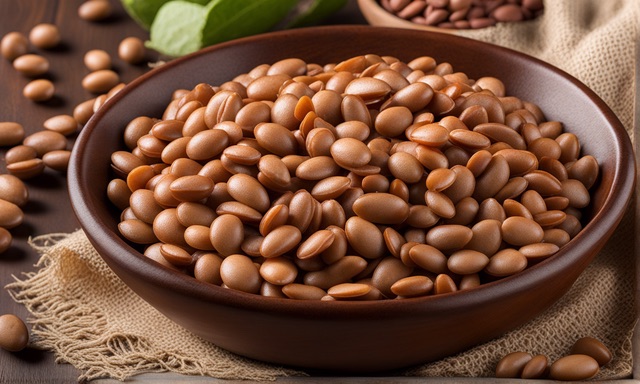Internet Asks: "Pinto Beans Glycemic Index"
In the quest for healthy eating, understanding the impact of foods on blood sugar levels is crucial, especially for those managing diabetes or watching their carbohydrate intake. Pinto beans, a staple in many cuisines, are often highlighted for their nutritional value. But how do they fare on the glycemic index (GI)? This article explores the glycemic index of pinto beans and what it means for your diet.
sponsored links

What are Pinto Beans?
Pinto beans are a variety of common beans, known for their speckled appearance. Widely used in Mexican and Southwestern American cuisine, they are cherished for their creamy texture and nutty flavor. Beyond their culinary appeal, pinto beans are packed with nutrients, including protein, fiber, vitamins, and minerals.
Nutritional Profile of Pinto Beans
- - High in Fiber: Pinto beans are an excellent source of dietary fiber, which aids in digestion and can help regulate blood sugar levels.
- - Rich in Protein: They are a good plant-based protein source, making them a great option for vegetarians and vegans.
- - Full of Vitamins and Minerals: Pinto beans contain essential nutrients like iron, magnesium, and potassium.
Understanding the Glycemic Index
The glycemic index is a scale that measures how much and how quickly a food raises blood glucose levels. Foods with a high GI are rapidly digested and absorbed, causing a quick spike in blood sugar, while low-GI foods are absorbed more slowly, leading to a gradual increase in blood sugar.
Glycemic Index of Pinto Beans
- Pinto beans have a low glycemic index, generally ranging between 29 and 45. This makes them an excellent food choice for stabilizing blood sugar levels.
- The low GI of pinto beans can be attributed to their high fiber content, which slows down the digestion and absorption of carbohydrates.
sponsored links
Health Benefits of Low-GI Foods Like Pinto Beans
- 1. Blood Sugar Management: Ideal for people with diabetes or those at risk, as they help in controlling blood glucose levels.
- 2. Satiety and Weight Management: High fiber content provides a feeling of fullness, which can aid in weight management.
- 3. Heart Health: Regular consumption of low-GI foods like pinto beans is associated with reduced risk of heart disease.
- 4. Digestive Health: The fiber in pinto beans promotes healthy digestion and regular bowel movements.
Incorporating Pinto Beans into Your Diet
Pinto beans are not only nutritious but also incredibly versatile in the kitchen, easily fitting into a variety of recipes:
- - As a Side Dish: Cooked pinto beans can be seasoned and served as a nutritious side.
- - In Soups and Stews: Add them to soups and stews for extra fiber and protein.
- - Bean Salads: Mix cooked pinto beans with vegetables and a light dressing for a healthy salad.
- - In Place of Meat: Use mashed pinto beans as a meat substitute in tacos, burritos, and more.
Conclusion
Pinto beans are not only versatile and delicious but also offer a wealth of nutritional benefits, including a low glycemic index. Their ability to moderate blood sugar levels makes them an excellent choice for anyone looking to maintain a healthy, balanced diet. By incorporating pinto beans into your meals, you can enjoy their rich nutritional profile while keeping your blood sugar levels in check.
Disclaimer: This article is for informational purposes only. It's always recommended to consult with healthcare professionals or nutritionists for personalized dietary advice, especially for managing health conditions like diabetes.
sponsored links
References
1. Harvard Health Publishing, Harvard Medical School. Glycemic index for 60+ foods. https://www.health.harvard.edu/diseases-and-conditions/glycemic-index-and-glycemic-load-for-100-foods
2. Fiona S. Atkinson, Kaye Foster-Powell, Jennie C. Brand-Miller; International Tables of Glycemic Index and Glycemic Load Values: 2008. Diabetes Care 1 December 2008; 31 (12): 2281–2283. https://doi.org/10.2337/dc08-1239
3. Medline Plus. Glycemic index and diabetes. https://medlineplus.gov/ency/patientinstructions/000941.htm
4. Mitchell DC, Lawrence FR, Hartman TJ, Curran JM. Consumption of dry beans, peas, and lentils could improve diet quality in the US population. J Am Diet Assoc. 2009 May;109(5):909-13. doi: 10.1016/j.jada.2009.02.029. PMID: 19394480.
5. U.S. Department of Agriculture. FoodData Central. Beans, pinto, mature seeds, cooked, boiled, without salt. https://fdc.nal.usda.gov/fdc-app.html#/food-details/175200/nutrients
6. Glycemic-Info. Pinto beans glycemic index. https://glycemic-info.com/products/pinto-beans-glycemic-index-load/
People are also reading...
️Starbucks Matcha Latte Calories
Matcha Green Tea Latte Starbucks Calories
See the answer to: "Matcha Green Tea Latte Starbucks Calories"
Starbucks Matcha Ingredients
Matcha Drinks at Starbucks
Does Sprite Have Caffeine?
Calories In Steak?
Chicken Taco Calories?
Does Hot Chocolate Have Caffeine?
Are Carrots Acidic?
Are Mangoes Acidic?
Orange Juice pH?
Calories In a Grilled Cheese?
Ready to level-up?
Create meal plans 10x faster, follow up with your clients through our mobile app, and never struggle with meal planning or recipe management again.